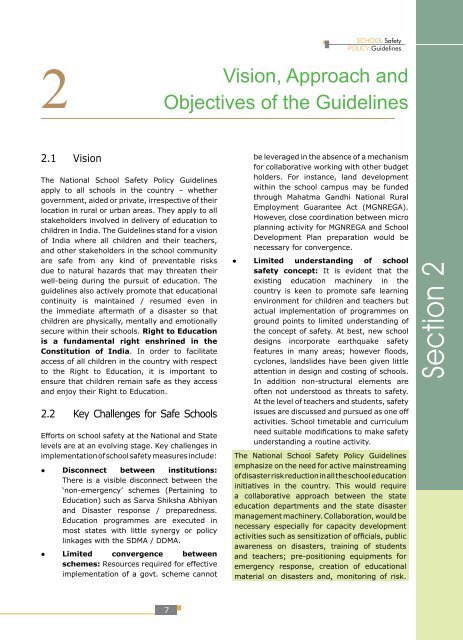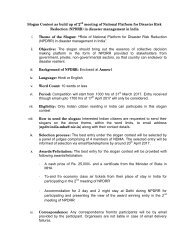National Disaster Management Guidelines School Safety Policy
School-Safety-Policy
School-Safety-Policy
You also want an ePaper? Increase the reach of your titles
YUMPU automatically turns print PDFs into web optimized ePapers that Google loves.
SCHOOL <strong>Safety</strong><br />
POLICY <strong>Guidelines</strong><br />
2<br />
Vision, Approach and<br />
Objectives of the <strong>Guidelines</strong><br />
2.1 Vision<br />
The <strong>National</strong> <strong>School</strong> <strong>Safety</strong> <strong>Policy</strong> <strong>Guidelines</strong><br />
apply to all schools in the country – whether<br />
government, aided or private, irrespective of their<br />
location in rural or urban areas. They apply to all<br />
stakeholders involved in delivery of education to<br />
children in India. The <strong>Guidelines</strong> stand for a vision<br />
of India where all children and their teachers,<br />
and other stakeholders in the school community<br />
are safe from any kind of preventable risks<br />
due to natural hazards that may threaten their<br />
well-being during the pursuit of education. The<br />
guidelines also actively promote that educational<br />
continuity is maintained / resumed even in<br />
the immediate aftermath of a disaster so that<br />
children are physically, mentally and emotionally<br />
secure within their schools. Right to Education<br />
is a fundamental right enshrined in the<br />
Constitution of India. In order to facilitate<br />
access of all children in the country with respect<br />
to the Right to Education, it is important to<br />
ensure that children remain safe as they access<br />
and enjoy their Right to Education.<br />
2.2 Key Challenges for Safe <strong>School</strong>s<br />
Efforts on school safety at the <strong>National</strong> and State<br />
levels are at an evolving stage. Key challenges in<br />
implementation of school safety measures include:<br />
● Disconnect between institutions:<br />
There is a visible disconnect between the<br />
‘non-emergency’ schemes (Pertaining to<br />
Education) such as Sarva Shiksha Abhiyan<br />
and <strong>Disaster</strong> response / preparedness.<br />
Education programmes are executed in<br />
most states with little synergy or policy<br />
linkages with the SDMA / DDMA.<br />
● Limited convergence between<br />
schemes: Resources required for effective<br />
implementation of a govt. scheme cannot<br />
be leveraged in the absence of a mechanism<br />
for collaborative working with other budget<br />
holders. For instance, land development<br />
within the school campus may be funded<br />
through Mahatma Gandhi <strong>National</strong> Rural<br />
Employment Guarantee Act (MGNREGA).<br />
However, close coordination between micro<br />
planning activity for MGNREGA and <strong>School</strong><br />
Development Plan preparation would be<br />
necessary for convergence.<br />
● Limited understanding of school<br />
safety concept: It is evident that the<br />
existing education machinery in the<br />
country is keen to promote safe learning<br />
environment for children and teachers but<br />
actual implementation of programmes on<br />
ground points to limited understanding of<br />
the concept of safety. At best, new school<br />
designs incorporate earthquake safety<br />
features in many areas; however floods,<br />
cyclones, landslides have been given little<br />
attention in design and costing of schools.<br />
In addition non-structural elements are<br />
often not understood as threats to safety.<br />
At the level of teachers and students, safety<br />
issues are discussed and pursued as one off<br />
activities. <strong>School</strong> timetable and curriculum<br />
need suitable modifications to make safety<br />
understanding a routine activity.<br />
The <strong>National</strong> <strong>School</strong> <strong>Safety</strong> <strong>Policy</strong> <strong>Guidelines</strong><br />
emphasize on the need for active mainstreaming<br />
of disaster risk reduction in all the school education<br />
initiatives in the country. This would require<br />
a collaborative approach between the state<br />
education departments and the state disaster<br />
management machinery. Collaboration, would be<br />
necessary especially for capacity development<br />
activities such as sensitization of officials, public<br />
awareness on disasters, training of students<br />
and teachers; pre-positioning equipments for<br />
emergency response, creation of educational<br />
material on disasters and, monitoring of risk.<br />
Section 2<br />
7



